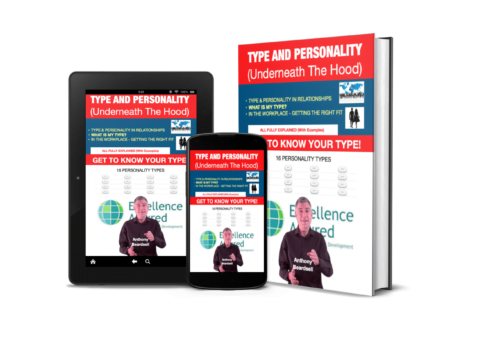ALL about the 16 Personality Types from under the hood
CLICK ON A TYPE below to view the 16 Personality Type profiles
Learn about the 16 Personality Types – This section of the website is designed to help you understand:
- what Personality Types are
- how types are constructed
- why they are useful to know
- how to discover your own personality type
- how to discover another persons type (and which one’s may attract you)
- how to use personality typing in the workplace
- what the 16 specific Personality Types mean to you
- how to use your new knowledge of personality types
- what else you need to know to get the whole picture
Don’t know your type? Discover your Personality Type.
Take one of our free personality type quizzes.
Option 1: FREE 2 minute personality quiz
Option 2: Simple (short version) 4 question personality test.
Know your type? Click one your type buttons above to see your profile.
Why is it useful to know my Personality Type?
By understanding your own personality type you begin to understand how your mind works. This means understanding:
- how you like to spend your time
- your preferences in terms of finding solutions and making decisions (and decisions shape your life, don’t they?)
- how you like to work
- How you like to be treated at work
- what you like and dislike about other people
Therefore gaining an understanding of your personality type will help you in several fundamental areas of your life: Better relationships, better self awareness and understanding, a better working life. Sound useful? Excellent. Read on…
Why is it useful to understand another persons personality type?
One word. Relationships. Are your relationships important to you? I thought so. I am talking about personal relationships and Personality Types AND use in professional relationships,
If you understand how people around you are thinking, then you can get on with them better and better influence and motivate them. This can therefore be beneficial in personal relationships and also in work environments, managing others, selling and other customer engagement roles.
Where does Personality Type theory come from?
The 16 personality types are derived from the work of Carl Jung. Jung wrote the definitive book Psychological Types in 1921 in which he observed that we all have four distinct parts to our personality:
- Where we focus our attention and energy (We are mainly Introverted or Extraverted)
- The way that we perceive the world and take in information (We are mainly Sensing or Intuiting)
- The way that we make decisions or judgements (We are mainly Thinking or Feeling)
- How we deal with the outside world (We are mainly Judging or Perceiving)
Utilising these four personality parts, psychological types are considered ways of describing and explaining certain consistent differences in the ways that people use their minds.

More on the 4 parts to personality
Buy our book “Type and Personalities – 16 Personality Types”
Click “Add to basket” and go your your cart
It is important to note a couple of things before we go on:
- Each of the personality types are considered equal
- Each of the four parts of personality should be considered continuums. Eg As individuals we are not 100% introvert or 100% extravert. We will be somewhere in between. Which means that we will have some introverted traits and some extraverted traits. We will also probably have a preference for one or the other, this is what determines our overall type.
What do the 16 4-letter combinations in personality stand for?
I=Introvert, E=Extravert, S=Sensor, N=Intuitor, T=Thinker, F=Feeler, J=Judger, P=Perceiver
- ISTJ Personality Type – Introvert, sensor, thinker, judger
- ISFJ Personality Type – Introvert, sensor, feeler, judger
- ESTP Personality Type – Extravert, sensor, thinker, perceiver
- ESFP Personality Type – Extravert, sensor. feeler, perceiver
- INTJ Personality Type – Introvert, intuitor (N), thinker, judger
- INFJ Personality Type– Intr0vert, intuitor, feeler, judger
- ENTP Personality Type – Extravert, intuitor, thinker, judger
- ENFP Personality Type – Extravert, intuitor, feeler, perceiver
- ISTP Personality Type – Introvert, sensor, thinker, perceiver
- INTP Personality Type – Introvert, intuitor, thinker, perceiver
- ESTJ Personality Type – Extravert, sensor, thinker, judger
- ENTJ Personality Type – Extravert, intuitor, thinker, judger
- ISFP Personality Type – Introvert, sensor, feeler, perceiver
- INFP Personality Type – Introvert, intuitor, feeler, perceiver
- ESFJ Personality Type – Extravert, sensor, feeler, judger
- ENFJ Personality Type – Extravert, intuitor, feeler, judger
Identifying personality type
Each of the four “parts” to personality type is a continuum. You will recognise certain words associated with your own or another’s personality. As you identify with some of the words it will give you an indication as to where on the continuum your personality fits.
This is a predictor only and shouldn’t be viewed as definitive.
Eg.
Part 1 – Introvert or Extravert (I or E)
(1) Introvert or Extravert (I or E)
Introvert
Receiving
Contained
Intimate
Reflective
Quiet
Extravert
Initiating
Expressive
Gregarious
Active
Enthusiastic
(2) Sensor or Intuitor (S or N)
Sensor
Concrete
Realistic
Practical
Experiential
Traditional
Intuitor
Abstract
Imaginative
Conceptual
Theoretical
(3) Thinker or Feeler (T or F)
Thinker
Logical
Reasonable
Questioning
Critical
Tough
Feeling
Empathetic
Compassionate
Accommodating
Accepting
Tender
(4) Judger or Perceiver (J or P)[
Judger
Systematic
Planful
Early Starting
Scheduled
Methodical
Perceiver
Casual
Open-ended
Pressure Prompted
Spontaneous
Emergent
In terms of these specific words. when you are considering your own “traits” you may find that it is easier to think of how others describe you or may have described perceiving you. Often people are able to associate these words with other people more easily than they are able to associate them accurately with themselves. We are talking about the “essence” of you and this is not something that we are always consciously aware of. This is one of the reasons why this system and discovering your personality is useful.
Eg We may like to consider ourselves “Spontaneous” – however is this really us? Some people who like to consider themselves as spontaneous are in fact spontaneous, others are less so (more scheduled). We may consider ourselves “Compassionate” and would “Reasonable” be a better description?
The way that your mind works, you when you consider each word a picture of someone you know may pop into your mind. I have one in my mind associated with the word “Open-ended” and unfortunately it isn’t myself (I’m more of a planner)!
Comparisons
As you look at the lists of words you may find it useful to compare them in order to identify your type more easily. The words are laid out above in a sequence that allows you to do that.
Examples:
- In terms of Introvert or Extravert, are you more Reflective or Gregarious? Are you more Active or Quiet?
- In terms of Thinker or Feeler, are you more Compassionate or Reasonable?
Don’t forget, you will have the capacity to be all of these things and so we are looking for your preference.
Your own personality preferences
As you begin to understand more about how the Types are made up and the four parts to them so you will begin to identify more and more with one side of the continuums over the other.
Have a read of the following to help you narrow down your choices:
(1) Introvert or Extravert (I or E)
Introvert
Good listener
Alone
Few close relationships
Sit in the background
One thing at a time
Think then speak
Internal validation
Extravert
Hugger
Party Organiser
Lots of friends
Group participation
Multi tasking
Speak first, think later
Outside validation
(2) Sensor or Intuitor (S or N)
Sensor
Facts, figures
Data
Tangible results
Task at hand
Don’t tend to fantasise much
In the now
Read magazine cover to cover
Intuitor
Relationship of ideas
Abstract
Like Puzzles
How things relate/work
Ideas & theories
Future Oriented
How does this all fit together?
(3) Thinker or Feeler (T or F)
Thinker
Detached thinking
Dissociated
Logic
Firm Minded
Decisions based on judgement
Objective
Feeling
Feelings
Associated
Harmony
Fair and just decisions
Decisions based on values
Want to do the “right thing” by others
(4) Judger or Perceiver (J or P)
Judger
On time
Make decisions easily
Fixed
Organised
Need Closure
Like to make lists
Perceiver
Punctuality less important
In the moment
“Play it by ear”
Adapt behaviour to others
No worries
High options
Having read this far you probably have a good inkling for which preferences you have. Are you an Introvert or an Extravert? A Sensor or an iNtuitor? A thinker or a feeler? A judger or a perceiver?
Still not sure? It is time to do a test.
How about a close relation, partner or friend. What Personality type would you give them based on the information that you have so far?
Now you know what your Personality type is and now you have an idea what type certain people around you are you might be thinking…..
“This is interesting but what can do I with this information?”
Good question…
Myers & Briggs determined that dependent upon our type (one of the 16 personality types), different parts of our personality have more influence over us than other parts and that these more dominant parts provide a level of definition over our character. Likewise, they considered that certain areas of our personality would be less prominent or we would be less keen to utilise these areas.
Therefore, if we know which areas we have a strong preference for, we can ensure that we are living our lives to our strengths (maximising our strengths). We can design our life and the way that we spend our time to ensure that we are creating the greatest potential for happiness.
If we know where our weaknesses lie, then we can focus our development on those areas so that we grow to our potential.
If we are in an organisation and we have a job vacancy that needs filling or a business problem, then we can design our ideal staff profile based on the specific requirements of the job or the problem.
If we are searching for a job opportunity, then we can identify the perfect roles to fit our own personality profile.
Myers & Briggs observed that parts or functions of personality could be prioritised as:
- Dominant Function – the preference with the most influence
- Auxiliary Function – next most influential part
- Tertiary Function – 3rd ranked in terms of influence
- Inferior Function – function with the least influence
How do we work out the dominant, auxiliary, tertiary and inferior functions of personality?
The next stage of the process involves applying rules to our four letter type:
1) Either letter 2 or 3 in the type (S/N or T/F) is the Dominant Function, the other is the Auxiliary Function.
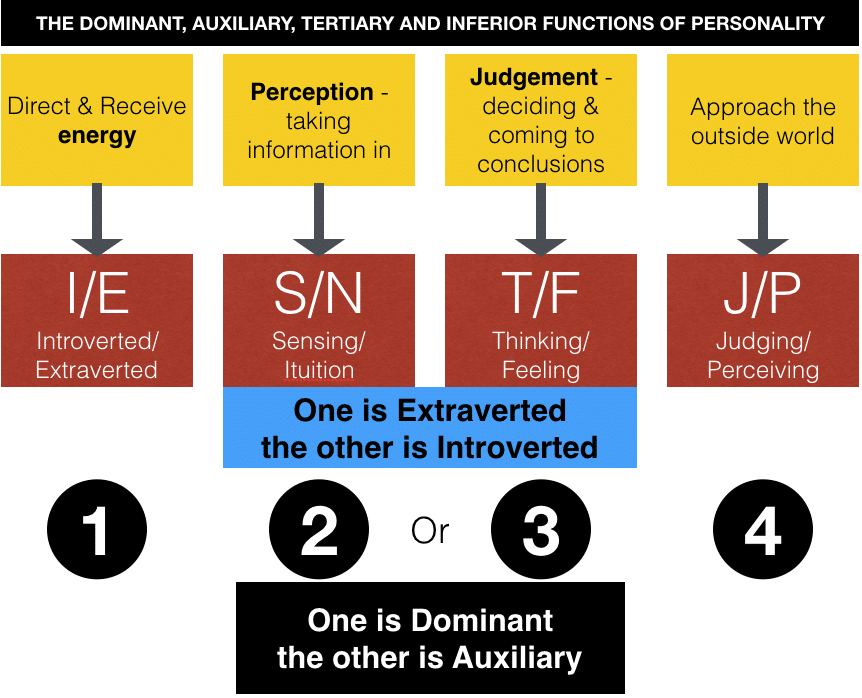
2) One of either letter 2 or 3 is Extraverted, the other is Introverted. See diagram above.
If J is the preference then T/F is extraverted (and therefore S/N is introverted).
If P is the preference then S/N is extraverted (and therefore T/F is introverted).
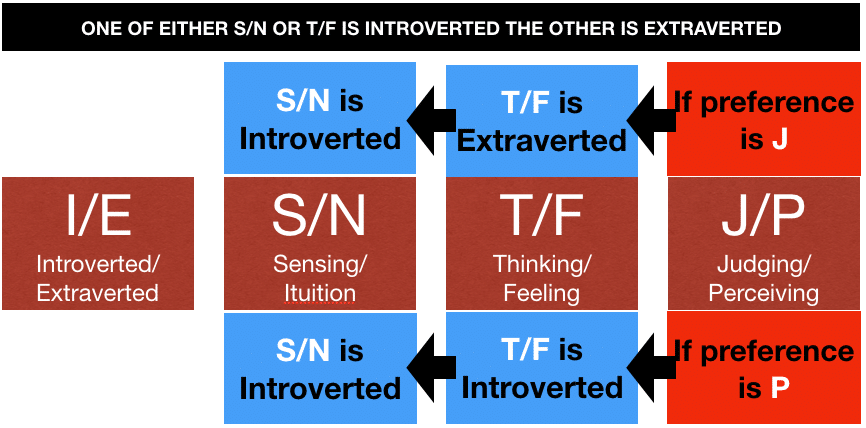
3) Letter 1 (I/E) tells us what the preferred attitude is, Extraversion or Introversion.
4) The dominant function is typically derived from the preferred attitude of I/E.
Therefore using the profile INTJ as an example:
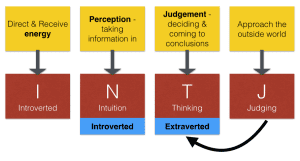
T is extraverted (determined by J) so N is introverted. Introverted Intuition is therefore the dominant function.
Using INTP as a second example:
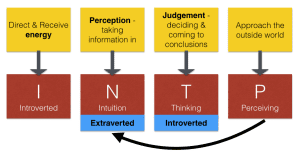
N is extraverted (determined by P) so T is introverted. Introverted Thinking is the dominant function.
5) The auxiliary function is the other letter of 2 or 3.
So in the case of example 1 – INTJ – it is Extraverted Thinking – giving (Dominant) Introverted Intuition and (Auxiliary) Extraverted Thinking.
In example 2 – INTP – it is Extraverted Intuition – giving (Dominant) Introverted Thinking and (Auxiliary) Extraverted Intuition.
6) The tertiary function is opposite to the auxiliary function.
EG INTJ it would be Feeling. For INTP it would be Sensing.
7) The inferior function is opposite to the dominant function.
EG INTJ it is Extraverted Sensing. For INFP it is Extraverted Feeling.
Fortunately for you we have done the work for you!
See the table below:
| Type | Dynamic Name (Dominant with Auxiliary) – Most likely, most comfortable | Tertiary | Inferior – Less likely, less comfortable |
| ISTJ | Introverted Sensing with Extraverted Thinking | Feeling | Extraverted Intuition |
| ISFJ | Introverted Sensing with Extraverted Feeling | Thinking | Extraverted Intuition |
| ESTP | Extraverted Sensing with Introverted Thinking | Feeling | Introverted Intuition |
| ESFP | Extraverted Sensing with Introverted Feeling | Thinking | Introverted Intuition |
| INTJ | Introverted Intuition with Extraverted Thinking | Feeling | Extraverted Sensing |
| INFJ | Introverted Intuition with Extraverted Feeling | Thinking | Extraverted Sensing |
| ENTP | Extraverted Intuition with Introverted Thinking | Feeling | Introverted Sensing |
| ENFP | Extraverted Intuition with Introverted Feeling | Thinking | Introverted Sensing |
| ISTP | Introverted Thinking with Extraverted Sensing | Intuition | Extraverted Feeling |
| INTP | Introverted Thinking with Extraverted Intuition | Sensing | Extraverted Feeling |
| ESTJ | Extraverted Thinking with Introverted Sensing | Intuition | Introverted Feeling |
| ENTJ | Extraverted Thinking with Introverted Intuition | Sensing | Introverted Feeling |
| ISFP | Introverted Feeling with Extraverted Sensing | Intuition | Extraverted Thinking |
| INFP | Introverted Feeling with Extraverted Intuition | Sensing | Extraverted Thinking |
| ESFJ | Extraverted Feeling with Introverted Sensing | Intuition | Introverted Thinking |
| ENFJ | Extraverted Feeling with Introverted Intuition | Sensing | Introverted Thinking |
What do these Personality type dynamics imply? What do they mean?
The dominant function implies that someone does it a lot, is comfortable doing it and is therefore probably good at it.
An inferior function is the opposite – normally a weakness.
Someone who’s Dynamic is:
- Introverted Sensing – favours (is good at and does a lot of) recalling facts and details of past events
- Extraverted Thinking – prefers dealing primarily with understanding and organizing the external world. Wants everything to make logical sense, and has very little patience of unproductive activities
- Extraverted Feeling – deals with understanding others emotions and feelings in the present moment
- Extraverted Sensing – lives in the present moment
- Introverted Thinking – wants the world to make sense in a logical manner
- Introverted Feeling – deals with the person’s own individual feelings and beliefs
- Introverted Intuition – deals with understanding how the world works through internal intuitive analysis
- Extraverted Intuition – deals with experiencing the outer world, noticing possibilities, and what could be
Now it is time to look at the different types in detail in order to see how they interact, compliment each other, conflict and consider what the development opportunities are for each type.
What is your Personality Type? Take our personality test for FREE now.


